By 1973, the T-72 was accepted for service and over 25,000 units were built, but the production lines never really shut down. The T-72, in its modernized form, now represents the bulk of the Russian armored forces, and was adopted by the best armored units in all Eastern Europe forces. It was widely exported despite its price -double of that of a T-55- because it represented a good compromise, not complicated to operate and maintain, with many commonalities with previous models. It was a real upgrade in firepower, protection, speed and even fire accuracy compared to previous models, and even contemporary western MBTs. Unlike the T-62, the T-72 became an instant hit, was well-modernized over decades and is still frontline today, in thirty-six armies.
Design
Although in its general shape the T-72 superficially resembled previous designs, and especially the T-62 (small turret, low hull, very long gun), there were many differences in the drivetrain, turret design, engine, main gun and equipment. Compared to western standards, its specifics were seen as drawbacks. Too small, it was seen as cramped and uncomfortable. It was believed in the west the crewmen had to be of small stature (1.60 m or 5ft 3in) but after the fall of the iron curtain, it appeared to have been officially 1.75 m (5ft 9in). For its designers and commanders, the vehicle was in line with the experience of the Soviet armored forces during the “Great Patriotic War”. The USSR modeled its tanks along a specific tactical use. Tanks were generally low, nimble and fast, being difficult to hit, contrary to western tanks which were, comparatively, at least 50 cm (1ft 8in) taller.
Crew comfort was seen as unnecessary, due to the survivability rates on the battlefield. The same law applied to a relatively non-refined interior and the simple, rugged, but efficient firing equipment, which was designed for production ease and easy maintenance. Any fragile and/or non-standard piece of equipment was therefore eliminated before production. This explained not only the production scale itself -much bigger than their western counterparts- but also their export success. Such manufacturing principles allowed costs to be kept very low, and at the same time produced a rugged piece of equipment which was durable, with part standardization (interchangeability) and relatively low-tech, which was an advantage in many pre-industrial countries, both for maintenance and upgrades.
Hull
The T-72 is small by western standards, and particularly low (about 60 cm/2 ft lower than its counterparts). This was a requirement which also helped to keep the total weight largely under the NATO practice. This allowed a great deal of mobility despite an aged V-12 diesel. For example, two T-72 could cross a bridge instead of waiting in line to cross it one at a time. This low profile was a problem when fording rivers more than 5 meters (16 ft) deep and a comprehensive sealing procedure, a snorkel and tightly waterproof interior were needed.
These fittings also helped NBC protection, rendered possible by a synthetic fabric made of boron compound lining which reduced (but did not) radiations. There was also an extensive air filter system with safety valves and constant over-pressure. This helped eliminate any poisonous contamination as well as residual fumes, that could leak out from the autoloader. Overall vision was not outstanding, with a set of extremely small periscope viewports. The hull construction called for an RHA (rolled homogenous armor) hull made of cast steel.
Armor
The hull’s basic RHA construction was augmented by spaced armor, which was upgraded to the T-64 standard composite armor in 1979. In the early 1980s, T-72s received additional add-on armor along with rubber side skirts, and, in the late 1980s, full ERA made of active protective tiles was generalized. At the origin, the basic cast armor was about 280 mm (11 in) at the thickest, with the nose up to 80 mm (3.1 in) and the glacis made of a 200 mm (7.9 in) thick laminated armor, well inclined. This gave a virtual equivalent of 500–600 mm (20–24 in) thickness against direct fire.
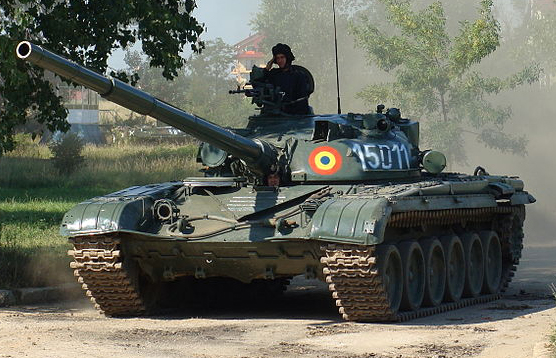
Drivetrain & powerplant
The V12 which was basically derived from the WW2 era 500 hp T-34 engine. Rugged and well-tested, it was also shared with the T-54/55 and T-62 families, meaning a lot of parts were interchangeable. It was capable of 780 hp (582 kW), which made the T-72 look undepowered compared to western tanks of the time, but its performances were kept high due to the lightweight hull. It was also much faster and nimbler than the T-62 and even the T-55. This engine was coupled to a synchromesh, hydraulically assisted, seven forward/one reverse gears transmission. The steering system is a traditional dual-tiller layout, rather than the steering wheel/yoke familiar in the west, imposing constant two-hands handling. By the 1980s, the powerplant upgraded to the new 840 bhp (630 kW) V-84 diesel.
The suspension set was a moderately new one, combining traditional torsion bars and shock dampers on the last and two first roadwheel sets. There were six evenly spaced sets of rubberized roadwheels per side. These roadwheels were completely redesigned and partly hollow, like the T-64 roadwheels, but made of steel rather than aluminum, due to costs and durability. They were also smaller and much lighter than the traditional “starfish” model, imposing four sets of return rollers to support the upper tracks. The tracks themselves were similar to the previous models, but not advanced like those of the T-64.
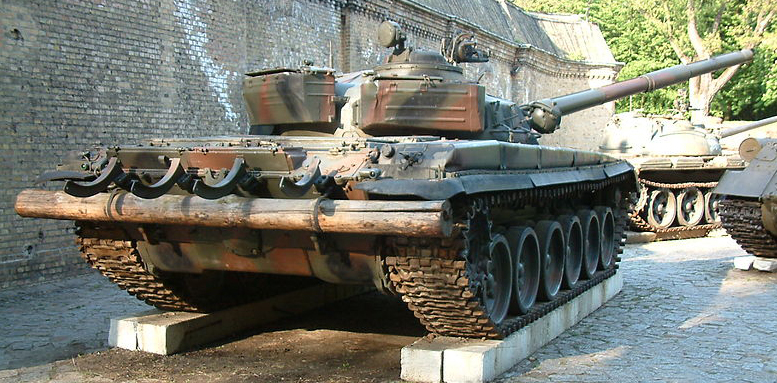
Turret
The turret was small in comparison to the T-62 and even the T-55, due to the elimination of the loader and its replacement by an auto-loader. The latter picked-up its rounds directly from a horizontal storage area (horizontally auto-fed), contrary to the faster and much more complex vertical actuators of the T-64 main gun automatic loader. The commander cupola was situated to the right rear, with four vision blocks, one periscope (later equipped with infrared sight), and a standard night illuminator. The gunner’s hatch was situated on the right-hand side and slightly angled down to the turret side.
He had one main periscope at his disposal and two additional vision block sights, plus the standard targeting sight with magnification. Target acquisition was manual under 1000 m (1,100 yds) but helped by parallax optical rangefinders above this distance. On later versions, this system was complemented by a laser rangefinder. It was seen as an expensive piece of equipment and in export version, only commander tanks (K) received one. Night vision imagery devices were generalized on Russian models in the 2000s, partly based on French technology (like the local Buran-Catherine system). These also are omitted from export versions.
The armor thickness was dictated by the shape, with was almost flat at the base, and the vertical section comprised a hollow space filled with sand (kvartz). It was called “Dolly Parton” by US intelligence. This thickness was believed to be about 200-250 mm (7.87-9.84 in). After further tests against various kind of ammunition, it was estimated to be the equivalent, at 1000 m, to 380 mm (15 in) for the T-72, 770/800 mm (30.3-31.5 in) on the T-72B with Kontakt 5 ERA vs. APFSDS rounds, and even 490 to 990 mm (19.3-39 in) vs. HEAT rounds. The late T-72B had the best level of protection among the Soviet-era tanks, even superior to the early T-90.
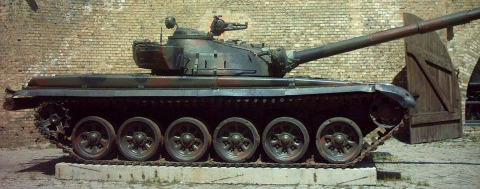
Armament
Surprisingly for its small size and weight, the T-72 main gun had a killer punch, well above the standard rifled L7 105 mm (4.13 in) and even superior to the 120 mm/L44 (4.72 in) NATO smoothbore tank guns (at least on paper). This 125 mm (4.9 in) 2A46 gun series was capable of firing HEAT and APFSDS “sabot” rounds, as well as ATGMs with folded winglets. Its ideal range was 1,800 m (1,970 yds) where it had a mean error of 1 m (39.4 in). The maximal range was limited by the turret shape, as customary with Soviet designs, with poor elevation that only allowed a range of 9000 m (9,952 yds). Depression was also very limited according to western standards. Maximum aimed fire range was about 4,000 m (4,375 yds) with ATGMs. The gun barrel had an integral pressure reserve drum for rapid smoke evacuation from the bore, and it was certified for ramming a 40 cm iron-reinforced brick wall. It received, early on, a thermal sleeve. However, the stabilizers were of average precision and it was usual to stop the tank in order to fire more accurately. It was assisted by the traditional “Luna” infrared illuminator. The autoloader had to crank up the breech-block three degrees above the horizontal in order to line it up with the new shell, compensated by the vertically independent gunner’s sight to keep the aim. Spent cartridges were ejected through a rear turret port. The normal rate of fire was about 8 rounds per minute.
Secondary armament comprised the usual coaxial 7.62 mm (0.3 in) PKT machine gun, fed with some 2500 cartridges, and the 12.7 mm (0.5 in) NSVT anti-aircraft machine gun, an enhanced, faster version of the old “Dushka”. It was strange to find such pieces of weaponry, intended for AA protection, at a time most attack jets were capable of strafing passes at Mach 1 and more, but they were aimed against attack helicopters. These became a real threat with the adoption of TOW and HOT missiles, as shown in the later part of the Vietnam war. Besides, this mid-size firepower was still an asset in ground engagements with softskin or lightly-armored targets.
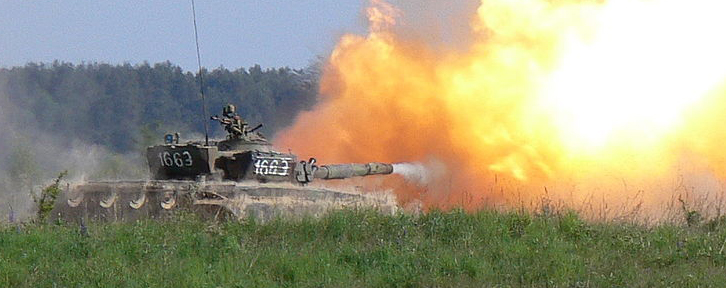
Production and variants
Only 600 of the early T-72 were built in 1973-79. The same year the T-72A was introduced, followed by the T-72B in 1985. The T-72 was also produced by the Czech, Romanian, Serbian, and Polish industries, by 10-12 other countries under (or without) license, and was declined in as many variants and derivatives as the T-54/55 family.
The T-72 “Ural” (1973)
This base version, derived from the Ob’yekt 172M, had the original 125 mm (4.92 in) D-81TM and searchlight mounted on the left, and the TPD-2-49 coincidence optical rangefinder sight. It was declined into the command version T-72K, fitted with more powerful sets for radio transmission. For the platoon leader (NATO K-1), R-130M radio, for company (NATO K-2) two R-123M/R-173 additional radios and 10 m (33 ft) telescopic mast, and for the battalion/regiment command versions (NATO K-3) wR-123M/R-173 additional radios and the R-130M. The Ob’yekt 172M-E, Ob’yekt 172M-E1, were tailored export versions, simplified, but with 44 rounds (Irak, Syria, and built in Poland as the “Bumar-Łabędy”).
There were three modernization phases, one in 1975-76 with the Ob’yekt 172-2M “Buffalo” (metal side skirts, more sloped glacis, 830 hp engine, turret add-on armor, smoke grenade launchers, reworked suspension, 45 rounds of ammo), and the T-72 “Ural-1” in 1976, with 2A46 main gun and reworked turret armor. Non-officially, T-72s later upgraded with ERA Kontakt-1 were named T-72V – “V” for vzryvnoi (explosive). The third phase (1980s) called for a relocated searchlight (right), modified TPD-2-49 coincidence optical rangefinder and fitting of rubber skirts.
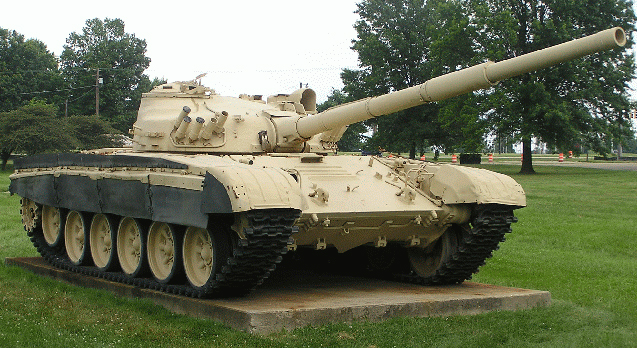
T-72A
Although it is derived from the T-72, protection was much improved (1979). This also included a relocated searchlight, TPD-K1 laser rangefinder and improved electronic FCS, MB smoke grenade launchers, two-level rubber panels protecting the upper part of the suspension and upper hull, “Dolly Parton” composite armor on the turret front and top, flipper armor on the front mudguards, and many internal changes. It was slightly heavier (42 short tons).
The AK-1/2/3 were the command equivalents (as above). In late 1979, a 17 mm (0.67 in) high resistance steel appliqué armor was added to the glacis. By 1984, a better anti-radiation lining was applied and, in the fall of the 1980s, ERA “Kontakt-1” was generalized with the T-72AV.
T-72 AM
Contrary to standard Soviet nomenclature, this was not a modernized version, but the export one, modified indeed. NATO codename was “Monkey”. These were generally downgraded versions, less costly and complex, with thinner armor. These were also built for export by Czechoslovakia and Poland. The T-72MK was the equivalent command versions (as above) NATO MK-1/2/3. The T-72M1 was the export equivalent to the upgraded T-72A/1979g with extra smoke grenade dischargers on turret front. It was produced by USSR, Poland and Czechoslovakia. The M1K-1/2/3 were the command variants, the M1V the ERA variant and the M1M the export version upgraded to the T-72B standard.
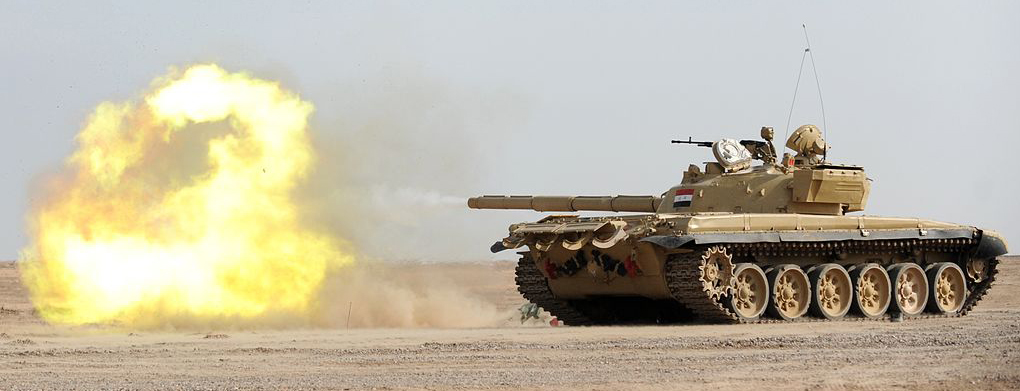
T-72B (1985)
A much-improved version, far better protected (the best of the whole series), with a composite-reinforced turret front and top known in the west as “Dolly Parton”. There was also an extra 20 mm (0.79 in) of appliqué armor on the glacis. It had a new 1A40-1 fire control system coupled with a 9K120 laser RF system to fire the ATGM 9M119 “Svir” (NATO AT-11 “Sniper”) laser-guided missile. There was also the new 2A46M main gun coupled with a 1K13-49 sight, new improved stabilization system, and a new V-84-1 engine (840 hp or 626 kW). The early models could be distinguished by the placement of their smoke dischargers mounted on the turret front and later grouped on the turret’s left side to make room for the ERA frontal protection.
T-72BA
The ERA version fitted with 227 “Kontakt-1” reactive armor blocks on the turret front and mid-sides, glacis, and with sideskirts.
T-72BK
The commander version, recognizable by the extra radio antenna and a radio mast stowage under the rear turret bin.
T-72S “Shilden”
The “downgraded” export version, with fewer ERA bricks, simplified NBC and no anti-radiation lining for the known features. The T-72B1 was a downgraded version without the ATGM capability, with the older T-72A optics, and modified ERA armor. The B1K was the command export version.
T-72B obr.1989g
The model 1989 had an improved Kontakt-5 ERA armor, and a “Dolly Parton” composite armor extended on the turret sides.
T-72B obr.1990g
Upgraded version with a new FCS coupled with a cross-wind sensor and the V-92S2 engine (not systematic). it also had an improved commander cupola sight. The T-72BU was developed from this version, giving birth to the T-90.
T-72BM “Rogatka” obr.2006g
Developed from the Object 184M, A Russian home defense and export version of the T-72B, modernized with a new gunner’s thermal sight, the “Nakidka” camouflage kit, a new 125 mm (4.92 in) 2A46M-5 main gun (muzzle reference system), propelled by the V-92S2 diesel engine (rated 1000 hp) and protected by the “Relikt” 3rd generation ERA.
T-72B3 (2013)
The ultimate, latest version, with an upgraded FCS and much improved ballistic computer, as well as a much improved thermal sight for day/night all-weather combat capabilities. It was first delivered to the 20th Armored Guards Brigade in October 2014, with a total delivery of 150 tanks of this type.
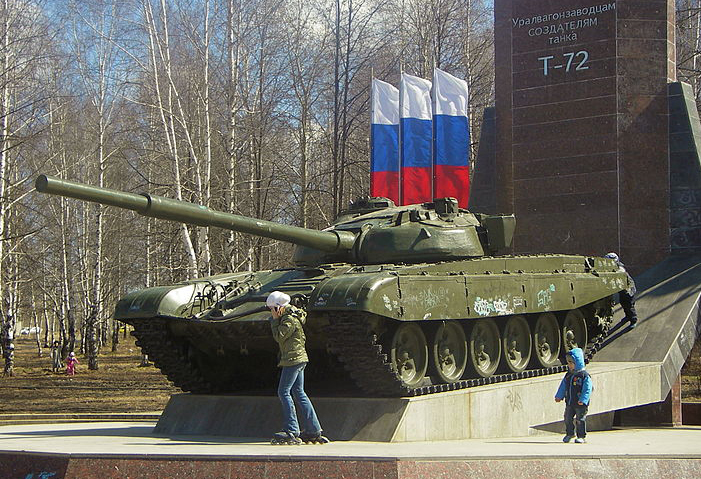
Price tag is an estimated 30,962,000 to 61,924,000 rubles (US$ 1–2 million) as of 2009, according to the Russian-Venezuelian deal.
Variants
Bulgarian T-72M2
An improved T-72M1 with IR/thermal sights, 650 mm (25.6 in) equivalent armor, anti-radiation lining, and rubber side skirts, treated with C4I and IR suppression coating.
Croatian M-95 Degman
3rd generation MBT based on the ex-Yugoslav M-91 Vihor prototype, itself based on the T-72 prior to the war. The M-85D is upgraded to the same standard.
Cuban T-72M1/M2
Local variants with Chinese radio set, tropicalized, and steel protection shield for the heavy AA machine-gun.
Czech T-72M
Local-built version built under licence by ZTS Martin in the late 1970s. The T-72G is the Middle East export version. By the 1980s, the export versions were modernized to the T-72A standard with side skirts and 902B “Tucha” smoke grenade launchers. The T-72M1 was the export version of the T-72A, and the VT-72 or BRAM-72, the standard Czech ARV.
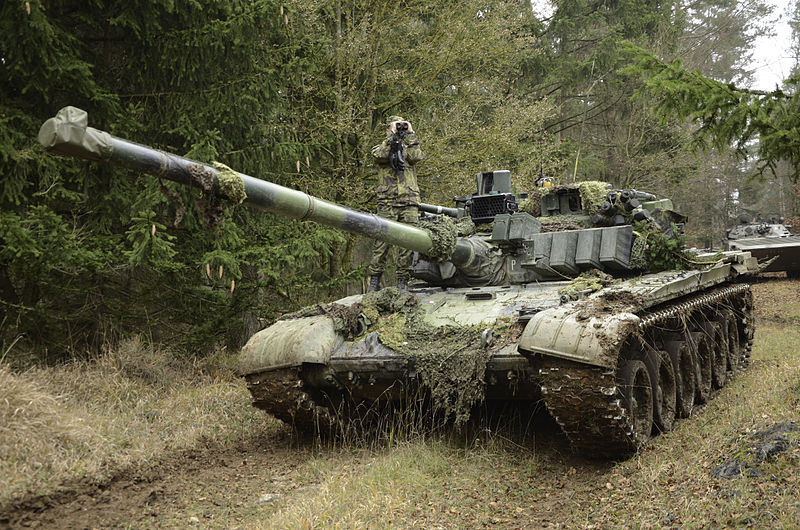
Czech T-72M4 CZ
Local production version derived from the rejected M3, with a custom design gunner and commander thermal image sights. The gunner’s one is a two part doors sight and the commander’s is a tall cylindrical one (as for the Leclerc MBT).
It has additional ERA protection and improved turret armor, MB smoke grenade dischargers, Galileo Avionica TURMS-T computerized FCS, Perkins CV12-1000 740 kW/1,000 hp diesel engine coupled with an Allison XTG-411-6 automatic transmission and completely reworked NIMDA suspension. 30 were upgraded recently this way.
East German versions
T-72M (1986) upgrade by RWM with rubber side skirts, “Tucha” smoke grenade launchers and the 16 mm add-on armour on the glacis plate. 23 T 72M “Übergangsversion” were Polish-built vehicles from 1986. T 72(K)/(K1) were the command versions. Also the T 72TK ARV (3), BLP 72 bridgelayer and FAB 172M or FAP 172U driver training version.
Georgian T-72 SIM-1
This version was upgraded with the K-5 “Kontakt” ERA, and received components from the Polish PT-91 Twardy, with a FALCON C&C system, GPS, SKO-1T DRAWA-T FCS with thermal sight, laser rangefinder and IFF.
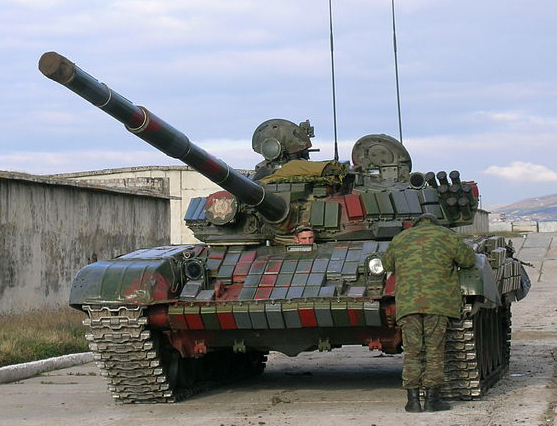

Polish versions
Poland was the second-largest producer of T-72s outside USSR. Notably the T-72M/M1 (“Monkey”) for export and the late version “Wilk” and “Twardy”.
The Polish T-72M/M1
Built by “Bumar-Łabędy” plant in Gwilice. Fitted with the initial “Gill armour”, then rubber side skirts and “Tucha” smoke dischargers. The M1 is the local version of the T-72A, upgraded with a 16 mm additional glacis plate but with less KMT mounts.
The T-72 “Wilk”
This local upgrade (1986) was equipped with a Czech-built Kladivo FCS or Polish Merida, as well as a Radomka illumination-free night vision sight, LIS-Varta night sight, Obra laser illumination warning system, Tellur anti-laser smoke dischargers and local-built ERA protection Erawa-1/2.
The PT-91 “Twardy” (1995)
A modern, 100% Polish MBT designed by OBRUM and based on the “Wilk” but with many new features. Currently in production by Bumarcombine with a PZL-Wola S-12U diesel (850 hp), Erawa-2 ERA (394 m2 bricks surface), steel side anti-cumulative screens, metal anti-HEAT screens, Drawa FCS plus TES, PCO SSC-1 Obra-1 laser illumination warning system, and US-DK-1 C&C central console. Followed by the PT-91A Twardy, PT-91Z Hardy, Malay PT-91M Pendekar and PT-91U optimized for urban combat.
Specialized variants
These are the PZA Loara and upgraded Loara-A – SPAAGs, SJ-09 driver-training vehicle, WZT-3 and 3M (based on the PT-91 Twardy) ARVs among others.
Romanian TR-125
The Romanian-built version of the T-72 with extra armor, modified suspension and a more powerful diesel engine.
Serbian M-84AS
The T-72 local vesion upgraded to the T-90 standard Yugoimport SDPR which also produce an export modernization package. The M-84AI is the ARV variant.
Slovakian T-72M1A
The main upgraded version in service today, based on the export M1. Features a DSM 16.1 engine monitoring system, full ERA and improved floor protection, better suspensions, fire detection/suppression system, laser warning, new driver, gunner and commander sights, Slovenian EFCS3-72A FCS, new electrical harness, S12U diesel engine, new smoke MB dischargers, and external sensor rod mounts.
The VT-72C is a derived ARV planned for India, and the VT-72Ž is the combat-engineering version based on a modernized VT-72B, but with a telescopic arm with bucket. The MT-72 is the Slovakian bridgelayer version, and the ShKH 2000 “Zuzana” a 155/45 mm SPG replacing the Dana based on the T-72M1 in the 1990s.
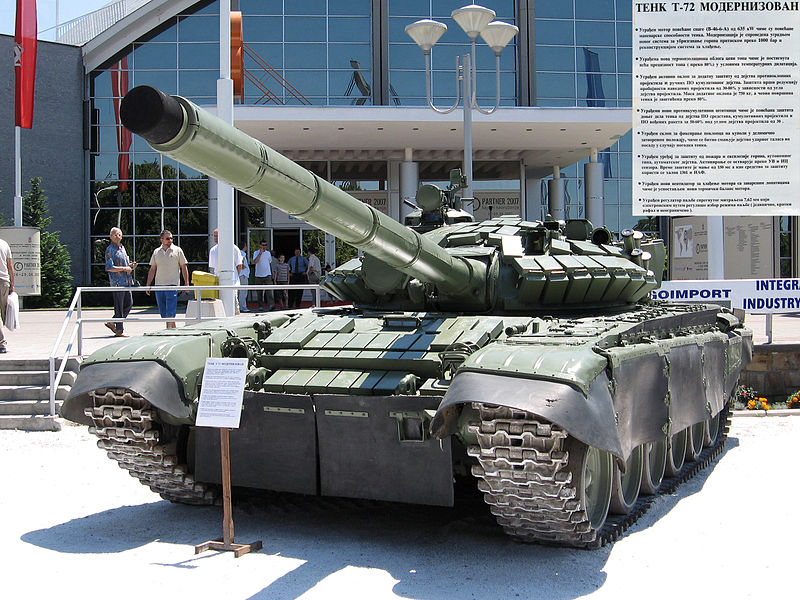
Yugoslavian M-84
The first one was a locally built T-72M but with some improvements over the original. The M-84A was based on the M1, with a local SUV-M-84 FCS, DNNS-2 gunner’s all-weather IR sight, 2-plane independent gun stabilization assisted by a local integral LR, plus a 1000 hp engine. The AK was the commander version with additional navigation equipment and radios, and the AB and export version (150 sold to Kuwait). The sub-variants ABK and ABN had extensive navigations equipment.
BMT-72
A new design including a smaller yet powerful powerpack coupled with a lenghtened hull and small troop compartment, with an extra pair of roadwheels. It’s a hybrid of MBT and APC.
BTS-5B
The Ukrainian version of the BREM-1 combat engineering vehicle.
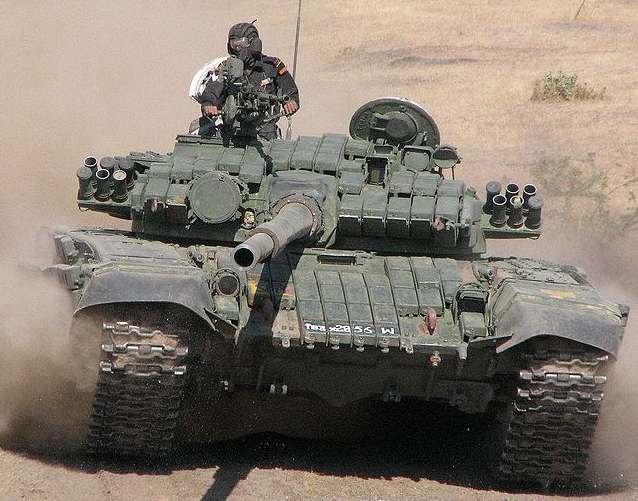
Operators by continent
Most Warsaw pact countries had considerable numbers of T-72s alongside USSR. Czechoslovakia for instance produced some 1700 T-72/M/M1 and still retained 815 in service for its armed forces in 1991. East germany had 583 T-72s/M/M1 from either USSR, Poland or Czechoslovakia (Reunified Germany sold, scrapped or preserved 549 of these). Finland operated in the 1980-1990s 170 T-72M1s, Romanian purchased 30 T-72Ms in 1978. They are now preserved or in reserve to be resold. Ukraine once had 1180 T-72s in the early 1990s. They were either upgraded to pur into reserve and sold, replaced by T-80/84s. The 80 ex-Yugoslav T-72s are now passed onto the Serbian army, completely modernized, as the M-84s.
Here follows a list of actual operators.
Africa
Algeria
Use some 500 T-72 which forms the bulk of its armoured forces.
Angola
The Angolan forces here used 22 ex-Bielorussian T-72M1s provided in 1999.
Djibouti
The small state operated 42 ex-Yemenite T-72s (third hand).
Ethiopia
50 ex-Yemenite and possibly 200 more ex-Ukrainian in 2011.
Kenya
The Kenyan army purchased 77 in 2002 and 22 in 2009 ex-Ukrainian T-72AVs (110 total).
Libya
Muhammad Gadaffi had a force of 150 T-72s as of 2012, and some were used by rebel forces.
Morocco
Purchased 136 B and 12 BK (command) from Belarus.
South Sudan
After the capture of Ukrainian ship MV Faina in 2009, 32 T-72s joined the 67 already operated by this army.
Sudan
Operates about 391 T-72s among these perhaps 200 are locally assembled under licence by MIC (Military Industry Corporation) after ex-Ukrainian and Bielorussian kits.
Yemen
Operates 39 T-72s as of 2003 (unknown origin).
Americas
Cuba
Operates about 150 M1s.
Venezuela
Owns about 192 T-72s obtained in two shipments (Ex-Russian) in 2009 and 2013-2014.
Asia
Armenia
The Armenian army counts 150 T-72M/M1s.
Azerbaïdjan
After 1990 the country was armed with about 636 ex-soviet T-72A, Bs and Aslan (locally modified).
Burma
Some 139 T-72s are in service.
Georgia
In 2011, Georgia had 180 A and T-72 S1M-1s.
India
Purchased 1900 T-72M/M1 as of 2009. Also produced locally as the Ajeya Mk.I/II.
Kazakhstan
This country had 980 T-72s enlisted as of 2009.
Kyrgyzstan
Some 215 T-72s are enlisted.
Mongolia
Has some 85 T-72s in service in the 2000s.
Tajikistan
Operates some 44 T-72s.
Uzbekistan
Operates 70 T-72s
Vietnam
Have some 480 M1s in service.
Europe
Belarus
The army still operates about 1465 T-72Bs.
Bulgaria
Due to budget cuts, only a fraction (80) of available T-72s are in service, some 350 are put in active reserve.
Czech Republic
As of 1993, 543 were in service but only 179 today.
Hungary
About 195 M/M1s were listed as of 2009, 113 are in reserve as of today.
Macedonia
Purchased 31 T-72As from Ukraine.
Poland
580 T-72M1/M1D (2009), 135 T-72M1Z, and 98 PT-91 Twardy.
Russia
Still operates 800 T-72BA ERA, 300 BM ERA, 3000 B ERA, and 1000 others in upgrade stage to the BM standard (Kontakt 5 ERA) plus 4000 in active reserve.
Russia
Middle East
Iran
Some 480 T-72 M/M1s were listed in 2002. Upgraded locally.
Iraq
Had about 1000 T-72s, M, M1, but also the locally built Saddam and Asad Babil in 1990. After 2003, their numbers had dwindled to 375, and only 125 are listed in the new Iraqi Army.
Syria
Had 1600 T-72 M/M1s in service, some were operated by rebels in 2012-2013.
The T-72 in action
In Soviet service, the T-72 formed the bulk of the armoured forces in case of a conventional war. They were hold back during the Afghan war, more expendable T-55 and T-62s being used instead. However with the fall of USSR, there was still a 4000-strong reserve. The oldest T-72 were replaced by T-90s while a significant numbers were about to be gradually modernized to the T-90 standard. Russian federation’s T-72s were committed in action in both Chechen wars, and in Georgia (South Ossetia war).
In the middle east
T-72s were actively engaged in several conflicts, starting in 1982 with the Syrian forces south of Lebanon, confronted with upgraded IDF M60A1s and Merkava tanks. After a famous clash on the eastern Beka’a, a Syrian Brigade from the 1st armoured division gave excellent account of itself against M60A1s, with almost no losses. But they were conflicting claims about the Israeli losses these days, attributed to RPG and well-hidden TOW missiles.
Iran-Iraq War
During the Iran-Iraq war, the Iraqi T-72s confronted Chieftains and M48/M60A1s with good results. At the early stage of the war, a single batallion claimed to have wiped out an entire Iranian unit equipped with Chieftains. Iraqi T-72s played also a major rôle in the battle for Basra and proved immune frontally to TOW and RPGs as well as 105 mm shells from the M60s. A total of 60 T-72s were lost during the 8-years conflict.
This confidence led to devise local versions like the Saddam and later the Asad Babil. However both models were “downgraded” versions of the “Monkey” (M for export models) from Poland and Czechoslovakia and performed quite poorly in 1991 1st gulf war and again in 2003.
Many of them were knock-out by long-range fire aided by infrared sights, and a few by hellfire missiles from the accompanying Bradley IFVs. This was well demonstrated in the famous Battle of 73 Easting which was almost entirely done during a sandstorm. The feared Iraqi Republican Guard T-72s were decimated by M1A1s with ease, with the loss of a single IFV on American side. Another similar engagement occured on 26 February 1991 at the Battle of Phase Line Bullet.
Arab Spring
During the “arab spring”, Libyan and Syrian T-72s were captured and turned back against regular forces recently. Syrian rebels showed that using IEDs and well-camouflaged RPGs were only successful in an urban environment at dangerously short distances, but they had more success later with ATGMs at longer, safer ranges.
In Asia
Indian T-72s were engaged in peace keeping operations during the long protracted Sri-Lankan civil war, starting in 1983. They were used mostly for infantry support.
Armenia clashed against similar T-72s from Azerbaidjan over a border dispute, the 1988–1994 Nagorno-Karabakh War. Georgian tanks were found in operations in Southern Ossetia and Abkhazia against Islamist rebels. In Tadjikistan, local opposition was also met by the T-72s committed by the Regime.
In Europe
T-72s saw heavy action in the Yugoslav wars (1991-2001), mostly on Serbian side, including the Croatian War of Independence, Kosovo and Macedonian conflicts.
In Africa
In the Sierra Leone Civil War, T-72s were apparently used by Executive Outcome, a private security company. T-72s were also engaged in the 1994 Rwanda Civil War and in the South Sudanese conflict in 2013. T-72s will certainly be used in operations in the 2020-2030s if not longer, unless there is a new revolution in AT weaponry.
T-72A specifications
Dimensions (L-W-H)9.24m (6.95m without gun) x 3.6m x 2.37m
(30’3″ (22’8″) x 11’8″ x 7’8″ ft.in)
Total weight, battle ready41.5 Tonnes
(45.7 tons or 65 000 lbs)
Crew4 (Cdr, driver, gunner, loader)
PropulsionV-12 diesel 780 hp (582 kw) 18.8 hp/t
Speed (land/water)42 km/h (26 mph)
Range/consumption490 km (290 mi) to 700 km (430 mi)/ 1,200 L with fuel drums
SupensionsTorsion bars and shock absorbers/dampers
ArmamentMain: 2A46M 125 mm sb (4.8 in) MG, 38 roundsec: Heavy 12.7 mm NSVT AA MG, PKT 7.62 mm coaxial
armourSteele and composite, see notes
Total productionApprox. 25 000
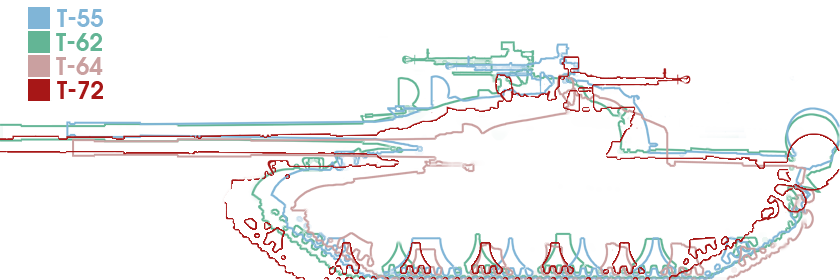
Design
Although in its general shape the T-72 superficially resembled previous designs, and especially the T-62 (small turret, low hull, very long gun), there were many differences in the drivetrain, turret design, engine, main gun and equipment. Compared to western standards, its specifics were seen as drawbacks. Too small, it was seen as cramped and uncomfortable. It was believed in the west the crewmen had to be of small stature (1.60 m or 5ft 3in) but after the fall of the iron curtain, it appeared to have been officially 1.75 m (5ft 9in). For its designers and commanders, the vehicle was in line with the experience of the Soviet armored forces during the “Great Patriotic War”. The USSR modeled its tanks along a specific tactical use. Tanks were generally low, nimble and fast, being difficult to hit, contrary to western tanks which were, comparatively, at least 50 cm (1ft 8in) taller.
Crew comfort was seen as unnecessary, due to the survivability rates on the battlefield. The same law applied to a relatively non-refined interior and the simple, rugged, but efficient firing equipment, which was designed for production ease and easy maintenance. Any fragile and/or non-standard piece of equipment was therefore eliminated before production. This explained not only the production scale itself -much bigger than their western counterparts- but also their export success. Such manufacturing principles allowed costs to be kept very low, and at the same time produced a rugged piece of equipment which was durable, with part standardization (interchangeability) and relatively low-tech, which was an advantage in many pre-industrial countries, both for maintenance and upgrades.
Hull
The T-72 is small by western standards, and particularly low (about 60 cm/2 ft lower than its counterparts). This was a requirement which also helped to keep the total weight largely under the NATO practice. This allowed a great deal of mobility despite an aged V-12 diesel. For example, two T-72 could cross a bridge instead of waiting in line to cross it one at a time. This low profile was a problem when fording rivers more than 5 meters (16 ft) deep and a comprehensive sealing procedure, a snorkel and tightly waterproof interior were needed.
These fittings also helped NBC protection, rendered possible by a synthetic fabric made of boron compound lining which reduced (but did not) radiations. There was also an extensive air filter system with safety valves and constant over-pressure. This helped eliminate any poisonous contamination as well as residual fumes, that could leak out from the autoloader. Overall vision was not outstanding, with a set of extremely small periscope viewports. The hull construction called for an RHA (rolled homogenous armor) hull made of cast steel.
Armor
The hull’s basic RHA construction was augmented by spaced armor, which was upgraded to the T-64 standard composite armor in 1979. In the early 1980s, T-72s received additional add-on armor along with rubber side skirts, and, in the late 1980s, full ERA made of active protective tiles was generalized. At the origin, the basic cast armor was about 280 mm (11 in) at the thickest, with the nose up to 80 mm (3.1 in) and the glacis made of a 200 mm (7.9 in) thick laminated armor, well inclined. This gave a virtual equivalent of 500–600 mm (20–24 in) thickness against direct fire.

Drivetrain & powerplant
The V12 which was basically derived from the WW2 era 500 hp T-34 engine. Rugged and well-tested, it was also shared with the T-54/55 and T-62 families, meaning a lot of parts were interchangeable. It was capable of 780 hp (582 kW), which made the T-72 look undepowered compared to western tanks of the time, but its performances were kept high due to the lightweight hull. It was also much faster and nimbler than the T-62 and even the T-55. This engine was coupled to a synchromesh, hydraulically assisted, seven forward/one reverse gears transmission. The steering system is a traditional dual-tiller layout, rather than the steering wheel/yoke familiar in the west, imposing constant two-hands handling. By the 1980s, the powerplant upgraded to the new 840 bhp (630 kW) V-84 diesel.
The suspension set was a moderately new one, combining traditional torsion bars and shock dampers on the last and two first roadwheel sets. There were six evenly spaced sets of rubberized roadwheels per side. These roadwheels were completely redesigned and partly hollow, like the T-64 roadwheels, but made of steel rather than aluminum, due to costs and durability. They were also smaller and much lighter than the traditional “starfish” model, imposing four sets of return rollers to support the upper tracks. The tracks themselves were similar to the previous models, but not advanced like those of the T-64.

Turret
The turret was small in comparison to the T-62 and even the T-55, due to the elimination of the loader and its replacement by an auto-loader. The latter picked-up its rounds directly from a horizontal storage area (horizontally auto-fed), contrary to the faster and much more complex vertical actuators of the T-64 main gun automatic loader. The commander cupola was situated to the right rear, with four vision blocks, one periscope (later equipped with infrared sight), and a standard night illuminator. The gunner’s hatch was situated on the right-hand side and slightly angled down to the turret side.
He had one main periscope at his disposal and two additional vision block sights, plus the standard targeting sight with magnification. Target acquisition was manual under 1000 m (1,100 yds) but helped by parallax optical rangefinders above this distance. On later versions, this system was complemented by a laser rangefinder. It was seen as an expensive piece of equipment and in export version, only commander tanks (K) received one. Night vision imagery devices were generalized on Russian models in the 2000s, partly based on French technology (like the local Buran-Catherine system). These also are omitted from export versions.
The armor thickness was dictated by the shape, with was almost flat at the base, and the vertical section comprised a hollow space filled with sand (kvartz). It was called “Dolly Parton” by US intelligence. This thickness was believed to be about 200-250 mm (7.87-9.84 in). After further tests against various kind of ammunition, it was estimated to be the equivalent, at 1000 m, to 380 mm (15 in) for the T-72, 770/800 mm (30.3-31.5 in) on the T-72B with Kontakt 5 ERA vs. APFSDS rounds, and even 490 to 990 mm (19.3-39 in) vs. HEAT rounds. The late T-72B had the best level of protection among the Soviet-era tanks, even superior to the early T-90.

Armament
Surprisingly for its small size and weight, the T-72 main gun had a killer punch, well above the standard rifled L7 105 mm (4.13 in) and even superior to the 120 mm/L44 (4.72 in) NATO smoothbore tank guns (at least on paper). This 125 mm (4.9 in) 2A46 gun series was capable of firing HEAT and APFSDS “sabot” rounds, as well as ATGMs with folded winglets. Its ideal range was 1,800 m (1,970 yds) where it had a mean error of 1 m (39.4 in). The maximal range was limited by the turret shape, as customary with Soviet designs, with poor elevation that only allowed a range of 9000 m (9,952 yds). Depression was also very limited according to western standards. Maximum aimed fire range was about 4,000 m (4,375 yds) with ATGMs. The gun barrel had an integral pressure reserve drum for rapid smoke evacuation from the bore, and it was certified for ramming a 40 cm iron-reinforced brick wall. It received, early on, a thermal sleeve. However, the stabilizers were of average precision and it was usual to stop the tank in order to fire more accurately. It was assisted by the traditional “Luna” infrared illuminator. The autoloader had to crank up the breech-block three degrees above the horizontal in order to line it up with the new shell, compensated by the vertically independent gunner’s sight to keep the aim. Spent cartridges were ejected through a rear turret port. The normal rate of fire was about 8 rounds per minute.
Secondary armament comprised the usual coaxial 7.62 mm (0.3 in) PKT machine gun, fed with some 2500 cartridges, and the 12.7 mm (0.5 in) NSVT anti-aircraft machine gun, an enhanced, faster version of the old “Dushka”. It was strange to find such pieces of weaponry, intended for AA protection, at a time most attack jets were capable of strafing passes at Mach 1 and more, but they were aimed against attack helicopters. These became a real threat with the adoption of TOW and HOT missiles, as shown in the later part of the Vietnam war. Besides, this mid-size firepower was still an asset in ground engagements with softskin or lightly-armored targets.

Production and variants
Only 600 of the early T-72 were built in 1973-79. The same year the T-72A was introduced, followed by the T-72B in 1985. The T-72 was also produced by the Czech, Romanian, Serbian, and Polish industries, by 10-12 other countries under (or without) license, and was declined in as many variants and derivatives as the T-54/55 family.
The T-72 “Ural” (1973)
This base version, derived from the Ob’yekt 172M, had the original 125 mm (4.92 in) D-81TM and searchlight mounted on the left, and the TPD-2-49 coincidence optical rangefinder sight. It was declined into the command version T-72K, fitted with more powerful sets for radio transmission. For the platoon leader (NATO K-1), R-130M radio, for company (NATO K-2) two R-123M/R-173 additional radios and 10 m (33 ft) telescopic mast, and for the battalion/regiment command versions (NATO K-3) wR-123M/R-173 additional radios and the R-130M. The Ob’yekt 172M-E, Ob’yekt 172M-E1, were tailored export versions, simplified, but with 44 rounds (Irak, Syria, and built in Poland as the “Bumar-Łabędy”).
There were three modernization phases, one in 1975-76 with the Ob’yekt 172-2M “Buffalo” (metal side skirts, more sloped glacis, 830 hp engine, turret add-on armor, smoke grenade launchers, reworked suspension, 45 rounds of ammo), and the T-72 “Ural-1” in 1976, with 2A46 main gun and reworked turret armor. Non-officially, T-72s later upgraded with ERA Kontakt-1 were named T-72V – “V” for vzryvnoi (explosive). The third phase (1980s) called for a relocated searchlight (right), modified TPD-2-49 coincidence optical rangefinder and fitting of rubber skirts.

T-72A
Although it is derived from the T-72, protection was much improved (1979). This also included a relocated searchlight, TPD-K1 laser rangefinder and improved electronic FCS, MB smoke grenade launchers, two-level rubber panels protecting the upper part of the suspension and upper hull, “Dolly Parton” composite armor on the turret front and top, flipper armor on the front mudguards, and many internal changes. It was slightly heavier (42 short tons).
The AK-1/2/3 were the command equivalents (as above). In late 1979, a 17 mm (0.67 in) high resistance steel appliqué armor was added to the glacis. By 1984, a better anti-radiation lining was applied and, in the fall of the 1980s, ERA “Kontakt-1” was generalized with the T-72AV.
T-72 AM
Contrary to standard Soviet nomenclature, this was not a modernized version, but the export one, modified indeed. NATO codename was “Monkey”. These were generally downgraded versions, less costly and complex, with thinner armor. These were also built for export by Czechoslovakia and Poland. The T-72MK was the equivalent command versions (as above) NATO MK-1/2/3. The T-72M1 was the export equivalent to the upgraded T-72A/1979g with extra smoke grenade dischargers on turret front. It was produced by USSR, Poland and Czechoslovakia. The M1K-1/2/3 were the command variants, the M1V the ERA variant and the M1M the export version upgraded to the T-72B standard.
T-72B (1985)
A much-improved version, far better protected (the best of the whole series), with a composite-reinforced turret front and top known in the west as “Dolly Parton”. There was also an extra 20 mm (0.79 in) of appliqué armor on the glacis. It had a new 1A40-1 fire control system coupled with a 9K120 laser RF system to fire the ATGM 9M119 “Svir” (NATO AT-11 “Sniper”) laser-guided missile. There was also the new 2A46M main gun coupled with a 1K13-49 sight, new improved stabilization system, and a new V-84-1 engine (840 hp or 626 kW). The early models could be distinguished by the placement of their smoke dischargers mounted on the turret front and later grouped on the turret’s left side to make room for the ERA frontal protection.
T-72BA
The ERA version fitted with 227 “Kontakt-1” reactive armor blocks on the turret front and mid-sides, glacis, and with sideskirts.
T-72BK
The commander version, recognizable by the extra radio antenna and a radio mast stowage under the rear turret bin.
T-72S “Shilden”
The “downgraded” export version, with fewer ERA bricks, simplified NBC and no anti-radiation lining for the known features. The T-72B1 was a downgraded version without the ATGM capability, with the older T-72A optics, and modified ERA armor. The B1K was the command export version.
T-72B obr.1989g
The model 1989 had an improved Kontakt-5 ERA armor, and a “Dolly Parton” composite armor extended on the turret sides.
T-72B obr.1990g
Upgraded version with a new FCS coupled with a cross-wind sensor and the V-92S2 engine (not systematic). it also had an improved commander cupola sight. The T-72BU was developed from this version, giving birth to the T-90.
T-72BM “Rogatka” obr.2006g
Developed from the Object 184M, A Russian home defense and export version of the T-72B, modernized with a new gunner’s thermal sight, the “Nakidka” camouflage kit, a new 125 mm (4.92 in) 2A46M-5 main gun (muzzle reference system), propelled by the V-92S2 diesel engine (rated 1000 hp) and protected by the “Relikt” 3rd generation ERA.
T-72B3 (2013)
The ultimate, latest version, with an upgraded FCS and much improved ballistic computer, as well as a much improved thermal sight for day/night all-weather combat capabilities. It was first delivered to the 20th Armored Guards Brigade in October 2014, with a total delivery of 150 tanks of this type.

Price tag is an estimated 30,962,000 to 61,924,000 rubles (US$ 1–2 million) as of 2009, according to the Russian-Venezuelian deal.
Variants
- BMO-T transport version (APC), for the RPO flamethrower squads.
- BMPT, heavy convoy protection IFV armed with a twin 30 mm (1.18 in) 2A42 autocannons, 9M133 Kornet ATGM, AGS-17/30 30 mm (1.18 in) grenade launchers and a 7.62 mm (0.3 in) PKT and optional armament, protected by “Relikt” ERA and “Kaktus” modular armor.
- TOS-1 turretless variant equipped with a multiple barrel rocker launcher (30 tubes), assisted by the TZMT supply variant.
- BREM-1, the standard ARV version with a 12-ton capacity front crane, a 25-100 ton winch, auxiliary winch, hydraulic dozer blade, extra tooling and equipment. The BREM-1M was the modernized version.
- IMR-2, the CIV version (genie), with a 11 ton cap. telescoping crane arm, V and T-shaped dozer blades, mine-clearing system and ground-raising system. Declined into the IMR-2M1 (better mine clearing system), IMR-2M2 (improved for contaminated areas), and IMR-2MA with an armed bigger operator’s cabin (12.7 mm/0.5 in NSV HMG).
- MTU-72, the bridgelayer version. The 6.4 ton bridge has a 20 m oa span x 3.3 m (21.9×3.6 yd) wide, max. 50 ton cap., could be deployed in 3 minutes.
- RKhM-7 “Berloga-1”, an NBC proof turretless version (replaced by a superstructure) reconnaissance vehicle.
Bulgarian T-72M2
An improved T-72M1 with IR/thermal sights, 650 mm (25.6 in) equivalent armor, anti-radiation lining, and rubber side skirts, treated with C4I and IR suppression coating.
Croatian M-95 Degman
3rd generation MBT based on the ex-Yugoslav M-91 Vihor prototype, itself based on the T-72 prior to the war. The M-85D is upgraded to the same standard.
Cuban T-72M1/M2
Local variants with Chinese radio set, tropicalized, and steel protection shield for the heavy AA machine-gun.
Czech T-72M
Local-built version built under licence by ZTS Martin in the late 1970s. The T-72G is the Middle East export version. By the 1980s, the export versions were modernized to the T-72A standard with side skirts and 902B “Tucha” smoke grenade launchers. The T-72M1 was the export version of the T-72A, and the VT-72 or BRAM-72, the standard Czech ARV.

Czech T-72M4 CZ
Local production version derived from the rejected M3, with a custom design gunner and commander thermal image sights. The gunner’s one is a two part doors sight and the commander’s is a tall cylindrical one (as for the Leclerc MBT).
It has additional ERA protection and improved turret armor, MB smoke grenade dischargers, Galileo Avionica TURMS-T computerized FCS, Perkins CV12-1000 740 kW/1,000 hp diesel engine coupled with an Allison XTG-411-6 automatic transmission and completely reworked NIMDA suspension. 30 were upgraded recently this way.
East German versions
T-72M (1986) upgrade by RWM with rubber side skirts, “Tucha” smoke grenade launchers and the 16 mm add-on armour on the glacis plate. 23 T 72M “Übergangsversion” were Polish-built vehicles from 1986. T 72(K)/(K1) were the command versions. Also the T 72TK ARV (3), BLP 72 bridgelayer and FAB 172M or FAP 172U driver training version.
Georgian T-72 SIM-1
This version was upgraded with the K-5 “Kontakt” ERA, and received components from the Polish PT-91 Twardy, with a FALCON C&C system, GPS, SKO-1T DRAWA-T FCS with thermal sight, laser rangefinder and IFF.


Polish versions
Poland was the second-largest producer of T-72s outside USSR. Notably the T-72M/M1 (“Monkey”) for export and the late version “Wilk” and “Twardy”.
The Polish T-72M/M1
Built by “Bumar-Łabędy” plant in Gwilice. Fitted with the initial “Gill armour”, then rubber side skirts and “Tucha” smoke dischargers. The M1 is the local version of the T-72A, upgraded with a 16 mm additional glacis plate but with less KMT mounts.
The T-72 “Wilk”
This local upgrade (1986) was equipped with a Czech-built Kladivo FCS or Polish Merida, as well as a Radomka illumination-free night vision sight, LIS-Varta night sight, Obra laser illumination warning system, Tellur anti-laser smoke dischargers and local-built ERA protection Erawa-1/2.
The PT-91 “Twardy” (1995)
A modern, 100% Polish MBT designed by OBRUM and based on the “Wilk” but with many new features. Currently in production by Bumarcombine with a PZL-Wola S-12U diesel (850 hp), Erawa-2 ERA (394 m2 bricks surface), steel side anti-cumulative screens, metal anti-HEAT screens, Drawa FCS plus TES, PCO SSC-1 Obra-1 laser illumination warning system, and US-DK-1 C&C central console. Followed by the PT-91A Twardy, PT-91Z Hardy, Malay PT-91M Pendekar and PT-91U optimized for urban combat.
Specialized variants
These are the PZA Loara and upgraded Loara-A – SPAAGs, SJ-09 driver-training vehicle, WZT-3 and 3M (based on the PT-91 Twardy) ARVs among others.
Romanian TR-125
The Romanian-built version of the T-72 with extra armor, modified suspension and a more powerful diesel engine.
Serbian M-84AS
The T-72 local vesion upgraded to the T-90 standard Yugoimport SDPR which also produce an export modernization package. The M-84AI is the ARV variant.
Slovakian T-72M1A
The main upgraded version in service today, based on the export M1. Features a DSM 16.1 engine monitoring system, full ERA and improved floor protection, better suspensions, fire detection/suppression system, laser warning, new driver, gunner and commander sights, Slovenian EFCS3-72A FCS, new electrical harness, S12U diesel engine, new smoke MB dischargers, and external sensor rod mounts.
The VT-72C is a derived ARV planned for India, and the VT-72Ž is the combat-engineering version based on a modernized VT-72B, but with a telescopic arm with bucket. The MT-72 is the Slovakian bridgelayer version, and the ShKH 2000 “Zuzana” a 155/45 mm SPG replacing the Dana based on the T-72M1 in the 1990s.

Yugoslavian M-84
The first one was a locally built T-72M but with some improvements over the original. The M-84A was based on the M1, with a local SUV-M-84 FCS, DNNS-2 gunner’s all-weather IR sight, 2-plane independent gun stabilization assisted by a local integral LR, plus a 1000 hp engine. The AK was the commander version with additional navigation equipment and radios, and the AB and export version (150 sold to Kuwait). The sub-variants ABK and ABN had extensive navigations equipment.
BMT-72
A new design including a smaller yet powerful powerpack coupled with a lenghtened hull and small troop compartment, with an extra pair of roadwheels. It’s a hybrid of MBT and APC.
BTS-5B
The Ukrainian version of the BREM-1 combat engineering vehicle.

Operators by continent
Most Warsaw pact countries had considerable numbers of T-72s alongside USSR. Czechoslovakia for instance produced some 1700 T-72/M/M1 and still retained 815 in service for its armed forces in 1991. East germany had 583 T-72s/M/M1 from either USSR, Poland or Czechoslovakia (Reunified Germany sold, scrapped or preserved 549 of these). Finland operated in the 1980-1990s 170 T-72M1s, Romanian purchased 30 T-72Ms in 1978. They are now preserved or in reserve to be resold. Ukraine once had 1180 T-72s in the early 1990s. They were either upgraded to pur into reserve and sold, replaced by T-80/84s. The 80 ex-Yugoslav T-72s are now passed onto the Serbian army, completely modernized, as the M-84s.
Here follows a list of actual operators.
Africa
Algeria
Use some 500 T-72 which forms the bulk of its armoured forces.
Angola
The Angolan forces here used 22 ex-Bielorussian T-72M1s provided in 1999.
Djibouti
The small state operated 42 ex-Yemenite T-72s (third hand).
Ethiopia
50 ex-Yemenite and possibly 200 more ex-Ukrainian in 2011.
Kenya
The Kenyan army purchased 77 in 2002 and 22 in 2009 ex-Ukrainian T-72AVs (110 total).
Libya
Muhammad Gadaffi had a force of 150 T-72s as of 2012, and some were used by rebel forces.
Morocco
Purchased 136 B and 12 BK (command) from Belarus.
South Sudan
After the capture of Ukrainian ship MV Faina in 2009, 32 T-72s joined the 67 already operated by this army.
Sudan
Operates about 391 T-72s among these perhaps 200 are locally assembled under licence by MIC (Military Industry Corporation) after ex-Ukrainian and Bielorussian kits.
Yemen
Operates 39 T-72s as of 2003 (unknown origin).
Americas
Cuba
Operates about 150 M1s.
Venezuela
Owns about 192 T-72s obtained in two shipments (Ex-Russian) in 2009 and 2013-2014.
Asia
Armenia
The Armenian army counts 150 T-72M/M1s.
Azerbaïdjan
After 1990 the country was armed with about 636 ex-soviet T-72A, Bs and Aslan (locally modified).
Burma
Some 139 T-72s are in service.
Georgia
In 2011, Georgia had 180 A and T-72 S1M-1s.
India
Purchased 1900 T-72M/M1 as of 2009. Also produced locally as the Ajeya Mk.I/II.
Kazakhstan
This country had 980 T-72s enlisted as of 2009.
Kyrgyzstan
Some 215 T-72s are enlisted.
Mongolia
Has some 85 T-72s in service in the 2000s.
Tajikistan
Operates some 44 T-72s.
Uzbekistan
Operates 70 T-72s
Vietnam
Have some 480 M1s in service.
Europe
Belarus
The army still operates about 1465 T-72Bs.
Bulgaria
Due to budget cuts, only a fraction (80) of available T-72s are in service, some 350 are put in active reserve.
Czech Republic
As of 1993, 543 were in service but only 179 today.
Hungary
About 195 M/M1s were listed as of 2009, 113 are in reserve as of today.
Macedonia
Purchased 31 T-72As from Ukraine.
Poland
580 T-72M1/M1D (2009), 135 T-72M1Z, and 98 PT-91 Twardy.
Russia
Still operates 800 T-72BA ERA, 300 BM ERA, 3000 B ERA, and 1000 others in upgrade stage to the BM standard (Kontakt 5 ERA) plus 4000 in active reserve.
Russia
Middle East
Iran
Some 480 T-72 M/M1s were listed in 2002. Upgraded locally.
Iraq
Had about 1000 T-72s, M, M1, but also the locally built Saddam and Asad Babil in 1990. After 2003, their numbers had dwindled to 375, and only 125 are listed in the new Iraqi Army.
Syria
Had 1600 T-72 M/M1s in service, some were operated by rebels in 2012-2013.
The T-72 in action
In Soviet service, the T-72 formed the bulk of the armoured forces in case of a conventional war. They were hold back during the Afghan war, more expendable T-55 and T-62s being used instead. However with the fall of USSR, there was still a 4000-strong reserve. The oldest T-72 were replaced by T-90s while a significant numbers were about to be gradually modernized to the T-90 standard. Russian federation’s T-72s were committed in action in both Chechen wars, and in Georgia (South Ossetia war).
In the middle east
T-72s were actively engaged in several conflicts, starting in 1982 with the Syrian forces south of Lebanon, confronted with upgraded IDF M60A1s and Merkava tanks. After a famous clash on the eastern Beka’a, a Syrian Brigade from the 1st armoured division gave excellent account of itself against M60A1s, with almost no losses. But they were conflicting claims about the Israeli losses these days, attributed to RPG and well-hidden TOW missiles.
Iran-Iraq War
During the Iran-Iraq war, the Iraqi T-72s confronted Chieftains and M48/M60A1s with good results. At the early stage of the war, a single batallion claimed to have wiped out an entire Iranian unit equipped with Chieftains. Iraqi T-72s played also a major rôle in the battle for Basra and proved immune frontally to TOW and RPGs as well as 105 mm shells from the M60s. A total of 60 T-72s were lost during the 8-years conflict.
This confidence led to devise local versions like the Saddam and later the Asad Babil. However both models were “downgraded” versions of the “Monkey” (M for export models) from Poland and Czechoslovakia and performed quite poorly in 1991 1st gulf war and again in 2003.
Many of them were knock-out by long-range fire aided by infrared sights, and a few by hellfire missiles from the accompanying Bradley IFVs. This was well demonstrated in the famous Battle of 73 Easting which was almost entirely done during a sandstorm. The feared Iraqi Republican Guard T-72s were decimated by M1A1s with ease, with the loss of a single IFV on American side. Another similar engagement occured on 26 February 1991 at the Battle of Phase Line Bullet.
Arab Spring
During the “arab spring”, Libyan and Syrian T-72s were captured and turned back against regular forces recently. Syrian rebels showed that using IEDs and well-camouflaged RPGs were only successful in an urban environment at dangerously short distances, but they had more success later with ATGMs at longer, safer ranges.
In Asia
Indian T-72s were engaged in peace keeping operations during the long protracted Sri-Lankan civil war, starting in 1983. They were used mostly for infantry support.
Armenia clashed against similar T-72s from Azerbaidjan over a border dispute, the 1988–1994 Nagorno-Karabakh War. Georgian tanks were found in operations in Southern Ossetia and Abkhazia against Islamist rebels. In Tadjikistan, local opposition was also met by the T-72s committed by the Regime.
In Europe
T-72s saw heavy action in the Yugoslav wars (1991-2001), mostly on Serbian side, including the Croatian War of Independence, Kosovo and Macedonian conflicts.
In Africa
In the Sierra Leone Civil War, T-72s were apparently used by Executive Outcome, a private security company. T-72s were also engaged in the 1994 Rwanda Civil War and in the South Sudanese conflict in 2013. T-72s will certainly be used in operations in the 2020-2030s if not longer, unless there is a new revolution in AT weaponry.
T-72A specifications
Dimensions (L-W-H)9.24m (6.95m without gun) x 3.6m x 2.37m
(30’3″ (22’8″) x 11’8″ x 7’8″ ft.in)
Total weight, battle ready41.5 Tonnes
(45.7 tons or 65 000 lbs)
Crew4 (Cdr, driver, gunner, loader)
PropulsionV-12 diesel 780 hp (582 kw) 18.8 hp/t
Speed (land/water)42 km/h (26 mph)
Range/consumption490 km (290 mi) to 700 km (430 mi)/ 1,200 L with fuel drums
SupensionsTorsion bars and shock absorbers/dampers
ArmamentMain: 2A46M 125 mm sb (4.8 in) MG, 38 roundsec: Heavy 12.7 mm NSVT AA MG, PKT 7.62 mm coaxial
armourSteele and composite, see notes
Total productionApprox. 25 000

